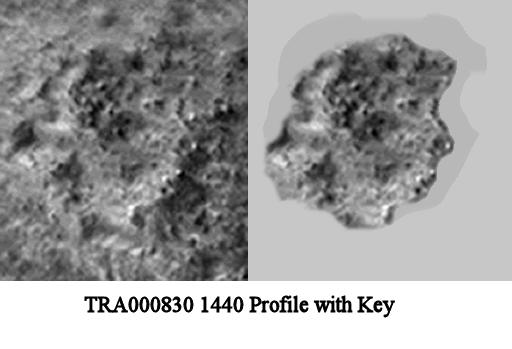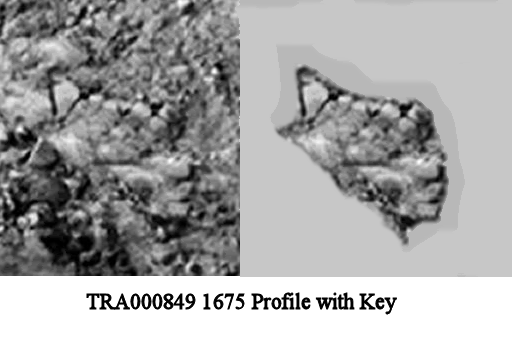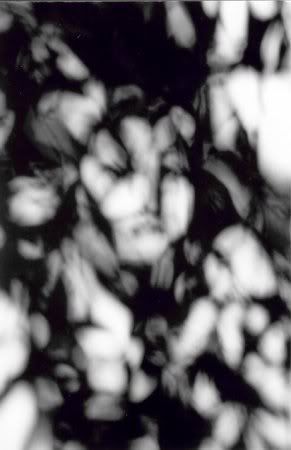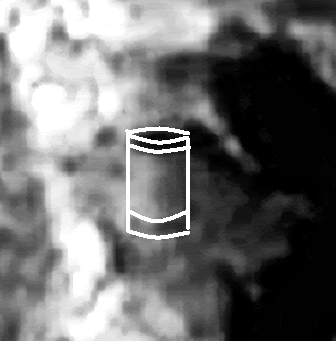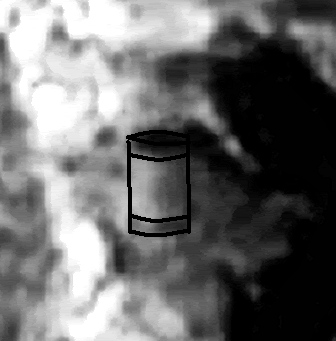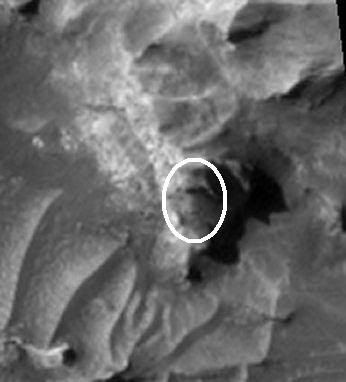- Thank you received: 0
Mro--First Looks
- neilderosa
-
- Offline
- Platinum Member
-

Less
More
18 years 5 months ago #17714
by neilderosa
Replied by neilderosa on topic Reply from Neil DeRosa
Some other possible artificial objects from the HIRISE images. TRA000830 1440, Profile girl.
TRA000849 1675, Profile girl.
Both are ~50 meters wide measured by the usual method. Both are fairly detailed and sharply focused etchings, (resolution of .5 m/p), showing the usual human-like profile features, including eye with outline, iris, white, and lash; nose with nostrils; mouth; hair or head piece; forehead; chin; neck; and suggestions of artistic shading, and lines to depict facial expression.
TRA000849 1675, Profile girl.
Both are ~50 meters wide measured by the usual method. Both are fairly detailed and sharply focused etchings, (resolution of .5 m/p), showing the usual human-like profile features, including eye with outline, iris, white, and lash; nose with nostrils; mouth; hair or head piece; forehead; chin; neck; and suggestions of artistic shading, and lines to depict facial expression.
Please Log in or Create an account to join the conversation.
- neilderosa
-
- Offline
- Platinum Member
-

Less
More
- Thank you received: 0
18 years 5 months ago #17715
by neilderosa
Replied by neilderosa on topic Reply from Neil DeRosa
<blockquote id="quote"><font size="2" face="Verdana, Arial, Helvetica" id="quote">quote:<hr height="1" noshade id="quote">In other words, if one turned in a blurry picture in a photography or microscopy class, they would not be happy with the grade they got on it. It doesn't bolster one's case, so they are not rewarded for it.
It could be that they didn't do a very good job of focusing when they were at the highest mag, or maybe they reached the limit of magnification of the tool, or maybe they forgot to go higher in mag and focus there first, and then back to the point they wanted to be at. There are many reasons.
In this case, you didn't actually take the picture yourself, so most of these things are unknown. But it still holds true. The best case you can make is with clear and sharp pictures. If the object you want to discuss is still too obscure or small, it might be better to leave it that way anyway, and suggest that we observers look at it through a magnifying glass. That might help slightly, but posting something blurry will never help your case.
The bottom line: What cylindrical object? [rd]
<hr height="1" noshade id="quote"></blockquote id="quote"></font id="quote">
I take this passage to be unserious, written for the purpose of making debate points as opposed to real scientific objections. Surely someone who just came out of months of numerous, vociferous, and well impassioned defenses of the blurry-art of Dr. Fred Rassler must be here speaking tongue-in-cheek.
Moreover, I recall just days ago , (after re-discovering artificiality of the Cydonia Face, after months of arguing doggedly that it was “pareidolia” ), you giving a finely detailed anatomical description of the C Face: and I quote; “Now, not only can you clearly see the nose and nostrils, but you can see the "columella" (the wall of flesh that divides the nostrils), and a faint hint of the "philtrum" (The philtrum is the midline groove in the upper lip that runs from the top of the lip to the nose). [rd, end of quote].”
Please let us know which of your statements and positions we are to take seriously.
...Anyway,
Back to the business of making my case. For those who require it, here are three keys for the possible cylindrical object just posted.
Remember, these are from the HIRISE images, the best detail we have yet.
It could be that they didn't do a very good job of focusing when they were at the highest mag, or maybe they reached the limit of magnification of the tool, or maybe they forgot to go higher in mag and focus there first, and then back to the point they wanted to be at. There are many reasons.
In this case, you didn't actually take the picture yourself, so most of these things are unknown. But it still holds true. The best case you can make is with clear and sharp pictures. If the object you want to discuss is still too obscure or small, it might be better to leave it that way anyway, and suggest that we observers look at it through a magnifying glass. That might help slightly, but posting something blurry will never help your case.
The bottom line: What cylindrical object? [rd]
<hr height="1" noshade id="quote"></blockquote id="quote"></font id="quote">
I take this passage to be unserious, written for the purpose of making debate points as opposed to real scientific objections. Surely someone who just came out of months of numerous, vociferous, and well impassioned defenses of the blurry-art of Dr. Fred Rassler must be here speaking tongue-in-cheek.
Moreover, I recall just days ago , (after re-discovering artificiality of the Cydonia Face, after months of arguing doggedly that it was “pareidolia” ), you giving a finely detailed anatomical description of the C Face: and I quote; “Now, not only can you clearly see the nose and nostrils, but you can see the "columella" (the wall of flesh that divides the nostrils), and a faint hint of the "philtrum" (The philtrum is the midline groove in the upper lip that runs from the top of the lip to the nose). [rd, end of quote].”
Please let us know which of your statements and positions we are to take seriously.
...Anyway,
Back to the business of making my case. For those who require it, here are three keys for the possible cylindrical object just posted.
Remember, these are from the HIRISE images, the best detail we have yet.
Please Log in or Create an account to join the conversation.
- tvanflandern
-
- Offline
- Platinum Member
-

Less
More
- Thank you received: 0
18 years 5 months ago #17815
by tvanflandern
Replied by tvanflandern on topic Reply from Tom Van Flandern
<blockquote id="quote"><font size="2" face="Verdana, Arial, Helvetica" id="quote">quote:<hr height="1" noshade id="quote"><i>Originally posted by neilderosa</i>
<br />I take this passage to be unserious, written for the purpose of making debate points as opposed to real scientific objections.<hr height="1" noshade id="quote"></blockquote id="quote"></font id="quote">Let me assure you that you are badly mistaken here. I couldn't see any hint of the "cylinder" either. Thank you for the key, which was absolutely essential for me to see <i>anything</i>. But such images still have a long way to go before they cross the line for me from pereidolia to artifacts.
The gap between Rich's views and mine about the Cydonia Face may have narrowed considerably of late. But when it comes to opinions about some of your images, Rich and I didn't have that much of a gap to start with.
Any example of established artificiality on Mars means that pereidolia and artificiality start on equal footing for other images. Equal footing is a long way from a good reason to consider them artificial. Each case must still be argued on its own merits. And blurry, over-pixelated images made of very few pixels (such as your cylinder) are prime candidates for pereidolia.
I often say to skeptics that, if some of these Mars images were shown to viewers who thought they occurred on Earth, estimates of the probability of their being artificial would be much higher. I feel I need to say the counterpart of that to you. If you were told that some of Fred's pereidolic images occurred on Mars, you seem susceptible to judging them artificial too.
But reality is that "what an image looks like" is often a poor discriminator beyween the two possibilities. Noisy backgrounds are especially fertile grounds for impressive pereidolia to occur. Contrast some of your better images in noisy backgrounds with this not-so-impressive image (right) in an unusually plain background (left).
<-- context
Do you see why this object might be more likely to be an artifact than a more impressive object in a noisy background? -|Tom|-
<br />I take this passage to be unserious, written for the purpose of making debate points as opposed to real scientific objections.<hr height="1" noshade id="quote"></blockquote id="quote"></font id="quote">Let me assure you that you are badly mistaken here. I couldn't see any hint of the "cylinder" either. Thank you for the key, which was absolutely essential for me to see <i>anything</i>. But such images still have a long way to go before they cross the line for me from pereidolia to artifacts.
The gap between Rich's views and mine about the Cydonia Face may have narrowed considerably of late. But when it comes to opinions about some of your images, Rich and I didn't have that much of a gap to start with.
Any example of established artificiality on Mars means that pereidolia and artificiality start on equal footing for other images. Equal footing is a long way from a good reason to consider them artificial. Each case must still be argued on its own merits. And blurry, over-pixelated images made of very few pixels (such as your cylinder) are prime candidates for pereidolia.
I often say to skeptics that, if some of these Mars images were shown to viewers who thought they occurred on Earth, estimates of the probability of their being artificial would be much higher. I feel I need to say the counterpart of that to you. If you were told that some of Fred's pereidolic images occurred on Mars, you seem susceptible to judging them artificial too.
But reality is that "what an image looks like" is often a poor discriminator beyween the two possibilities. Noisy backgrounds are especially fertile grounds for impressive pereidolia to occur. Contrast some of your better images in noisy backgrounds with this not-so-impressive image (right) in an unusually plain background (left).
<-- context
Do you see why this object might be more likely to be an artifact than a more impressive object in a noisy background? -|Tom|-
Please Log in or Create an account to join the conversation.
18 years 5 months ago #17818
by rderosa
Replied by rderosa on topic Reply from Richard DeRosa
<blockquote id="quote"><font size="2" face="Verdana, Arial, Helvetica" id="quote">quote:<hr height="1" noshade id="quote"><i>Originally posted by neilderosa</i>
<br />Surely someone who just came out of months of numerous, vociferous, and well impassioned defenses of the blurry-art of Dr. Fred R(e)ssler must be here speaking tongue-in-cheek.<hr height="1" noshade id="quote"></blockquote id="quote"></font id="quote">I've been trying to avoid being repetitive and I know I addressed this issue on many occasions, but since you keep coming back to this objection, I feel I must clarify it again.
Fred's work is known paredolic art. He's presenting it to the world as a "what you see is what you get" artwork. As far as I've been able to tell, he's not trying to "prove" anything. As a matter of fact, he's gone on record and so much as said he believes nobody can prove anything.
When I posted references to his work, they were merely being used as examples of what I considered to be detailed "faces" that we all knew were paredolia. I was doing a sort of "compare and contrast" with some of your postings of what you considered to be Martian Art. I wasn't doing a science experiment in the literal sense, where I was attempting to prove the existence of something <b>in</b> the photographs, I was just saying, here's how elaborate some known pieces of paradolia are. I've said this many times, but for some reason you refuse to accept that.
On the other hand, when you post a "cylindrical object", or any other proposed artwork, you are in effect saying, here's an object that was made by a Martian civilization possibly from 3.5 million years ago or more. So, you're taking an image that was taken from a spaceship and claiming that you "found" an artifact in that image.
That's an entirely different case than the way I was using Fred's art. You're making a claim that something in the picture is real, and Martian made. Neither I nor Fred are making such a claim.
I was merely pointing out to you, and rightly so, that if you are going to make such claims, it doesn't help your case if the artifact is so blurry as to make it virtually impossible to see. I was explaining that within the context of real science, not Fred's art. Like you said many times, an artist can do whatever he wants. If he wants two ears on one side of the head, that's fair game. Look at cubism, surrealism, abstract art, modernism and impressionism, as examples.
So, your objection based on Fred's "Lila", is not valid, but my comments about blurry images in the context of a science experiment are valid.
rd
<br />Surely someone who just came out of months of numerous, vociferous, and well impassioned defenses of the blurry-art of Dr. Fred R(e)ssler must be here speaking tongue-in-cheek.<hr height="1" noshade id="quote"></blockquote id="quote"></font id="quote">I've been trying to avoid being repetitive and I know I addressed this issue on many occasions, but since you keep coming back to this objection, I feel I must clarify it again.
Fred's work is known paredolic art. He's presenting it to the world as a "what you see is what you get" artwork. As far as I've been able to tell, he's not trying to "prove" anything. As a matter of fact, he's gone on record and so much as said he believes nobody can prove anything.
When I posted references to his work, they were merely being used as examples of what I considered to be detailed "faces" that we all knew were paredolia. I was doing a sort of "compare and contrast" with some of your postings of what you considered to be Martian Art. I wasn't doing a science experiment in the literal sense, where I was attempting to prove the existence of something <b>in</b> the photographs, I was just saying, here's how elaborate some known pieces of paradolia are. I've said this many times, but for some reason you refuse to accept that.
On the other hand, when you post a "cylindrical object", or any other proposed artwork, you are in effect saying, here's an object that was made by a Martian civilization possibly from 3.5 million years ago or more. So, you're taking an image that was taken from a spaceship and claiming that you "found" an artifact in that image.
That's an entirely different case than the way I was using Fred's art. You're making a claim that something in the picture is real, and Martian made. Neither I nor Fred are making such a claim.
I was merely pointing out to you, and rightly so, that if you are going to make such claims, it doesn't help your case if the artifact is so blurry as to make it virtually impossible to see. I was explaining that within the context of real science, not Fred's art. Like you said many times, an artist can do whatever he wants. If he wants two ears on one side of the head, that's fair game. Look at cubism, surrealism, abstract art, modernism and impressionism, as examples.
So, your objection based on Fred's "Lila", is not valid, but my comments about blurry images in the context of a science experiment are valid.
rd
Please Log in or Create an account to join the conversation.
- neilderosa
-
- Offline
- Platinum Member
-

Less
More
- Thank you received: 0
18 years 5 months ago #19011
by neilderosa
Replied by neilderosa on topic Reply from Neil DeRosa
<blockquote id="quote"><font size="2" face="Verdana, Arial, Helvetica" id="quote">quote:<hr height="1" noshade id="quote">Do you see why this object might be more likely to be an artifact than a more impressive object in a noisy background? -|Tom|-
<hr height="1" noshade id="quote"></blockquote id="quote"></font id="quote">
The short answer is no. The reason is that I don’t know what I’m looking at here at all. After you give the link so I can check the original, I’ll answer the question.
<blockquote id="quote"><font size="2" face="Verdana, Arial, Helvetica" id="quote">quote:<hr height="1" noshade id="quote">I couldn't see any hint of the "cylinder" either. Thank you for the key, which was absolutely essential for me to see anything. [Tom]
<hr height="1" noshade id="quote"></blockquote id="quote"></font id="quote">
It’s easy to overlook the fact that individuals vary widely in their ability to pick out small objects either in a noisy background or at a distance, or in the ability to interpret subtleties in shading. All sorts of psychological and visual skills are involved, not to mention talent and training. I’m not saying I’m positive this is a cylinder, but I’m much more confident than I was previously, having seen them before in other images. I was impressed by the fact that in an image with .5 m/p resolution, the cylinder measured 9.38 meters wide (at 100%, object measures 3/32" = .09375 x 200 p/inch =18.75 pixels x.5 m/p = 9.38 meters wide.) The HIRISE managers advertise that we can distinguish boulders 1 meter across. The cylinder is significantly larger than that. There is adequate pixelation here to distinguish an object the shape of a cylinder. For example, if the cylinder's dimensions were 10m x 30m, it would contain 600 pixels. (10 x 30 = 600). Some of us undoubtedly now see a cylinder, though it can’t be proven yet.
BTW, I don’t think the word “pareidolia” pertains to inanimate objects like cylinders. Perhaps we need to coin a new word.
As for the rest of your message, I’ll have to respectfully disagree with your assessment.
<hr height="1" noshade id="quote"></blockquote id="quote"></font id="quote">
The short answer is no. The reason is that I don’t know what I’m looking at here at all. After you give the link so I can check the original, I’ll answer the question.
<blockquote id="quote"><font size="2" face="Verdana, Arial, Helvetica" id="quote">quote:<hr height="1" noshade id="quote">I couldn't see any hint of the "cylinder" either. Thank you for the key, which was absolutely essential for me to see anything. [Tom]
<hr height="1" noshade id="quote"></blockquote id="quote"></font id="quote">
It’s easy to overlook the fact that individuals vary widely in their ability to pick out small objects either in a noisy background or at a distance, or in the ability to interpret subtleties in shading. All sorts of psychological and visual skills are involved, not to mention talent and training. I’m not saying I’m positive this is a cylinder, but I’m much more confident than I was previously, having seen them before in other images. I was impressed by the fact that in an image with .5 m/p resolution, the cylinder measured 9.38 meters wide (at 100%, object measures 3/32" = .09375 x 200 p/inch =18.75 pixels x.5 m/p = 9.38 meters wide.) The HIRISE managers advertise that we can distinguish boulders 1 meter across. The cylinder is significantly larger than that. There is adequate pixelation here to distinguish an object the shape of a cylinder. For example, if the cylinder's dimensions were 10m x 30m, it would contain 600 pixels. (10 x 30 = 600). Some of us undoubtedly now see a cylinder, though it can’t be proven yet.
BTW, I don’t think the word “pareidolia” pertains to inanimate objects like cylinders. Perhaps we need to coin a new word.
As for the rest of your message, I’ll have to respectfully disagree with your assessment.
Please Log in or Create an account to join the conversation.
- neilderosa
-
- Offline
- Platinum Member
-

Less
More
- Thank you received: 0
18 years 5 months ago #17721
by neilderosa
Replied by neilderosa on topic Reply from Neil DeRosa
<blockquote id="quote"><font size="2" face="Verdana, Arial, Helvetica" id="quote">quote:<hr height="1" noshade id="quote">When I posted references to his work, they were merely being used as examples of what I considered to be detailed "faces" that we all knew were pareidolia.[rd]<hr height="1" noshade id="quote"></blockquote id="quote"></font id="quote">
You still don't understand the distinction, though I’ve explained it many times.
"We all knew?" Who says? You have to demonstrate and prove your case--just like everyone else. You did so with blurry pictures, and you said they meant something (i.e. they looked like faces). But they were blurry, and so I ask… What faces?
What's good for the goose is good for the gander. As they say in Missouri.
You still don't understand the distinction, though I’ve explained it many times.
"We all knew?" Who says? You have to demonstrate and prove your case--just like everyone else. You did so with blurry pictures, and you said they meant something (i.e. they looked like faces). But they were blurry, and so I ask… What faces?
What's good for the goose is good for the gander. As they say in Missouri.
Please Log in or Create an account to join the conversation.
Time to create page: 0.364 seconds

